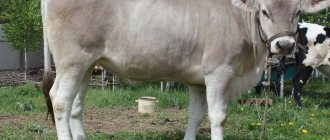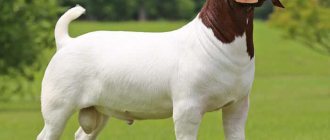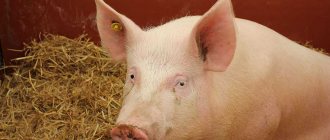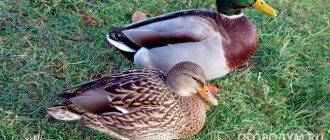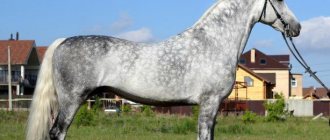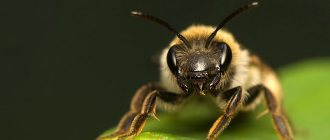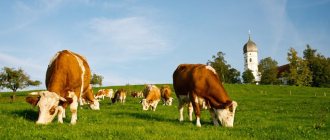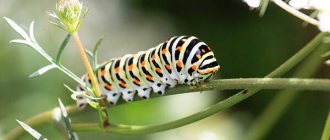Holstein cows are a dairy breed developed in the United States in the nineteenth century by breeders. It has a characteristic spotted color, large body weight (up to 900 kilograms for bulls), and produces high milk yields - up to 8000 kilograms of milk per year. Suitable for both small private households and farms. Susceptible to stress, changes in diet, temperature conditions in the barn - these factors can reduce the productivity of the livestock. In this material we will analyze what the characteristics of this type of cow are, what pros and cons this breed has in breeding, how to properly care for Holstein cows, how to ensure their breeding, and also what diseases representatives of this species are susceptible to.
Appearance and description of Holsteinized cattle
The Holstein breed of cows appeared due to the crossing of several species of individuals from European countries. The main breeding work was carried out at the beginning of the 19th century in the USA, when the American farmer W. Chenery bought himself a pair of black-and-white cows.
He was pleasantly surprised to notice the high-quality milk yield. Over the next years, the farmer improved this breed and developed a new one. From the beginning of 1980 to the present day, the breed is called Holstein, although some sources still mention the old name - Holstein-Friesian.
Reference. The weight of a Holstein cow starts from 600 and ends at 900 kg (heifers) and up to 1000–1200 kg (calves). The height of the female individual is 145 cm, and the male one is more than 1.5 meters. Newly born calves already weigh 40–45 kg.
The quality of dairy products directly depends on the living conditions of livestock. For example, an American cow can produce 8 tons of milk per year with a fat content of more than 3.5%. During the day, the milk yield of one cow can reach 70 kg of milk. In Israeli conditions, it is possible to produce about 10 tons of milk per year, with a fat content of up to 3%. In Russia and Belarus, a cow produces from 7 to 7.5 thousand kg per year. Fat content is about 4%. It is not for nothing that this breed is considered the most dairy breed in the world.
History of origin
Several centuries ago, German settlers came to the lands of North Holland and Friesland, where they brought their cattle with them. They crossed them with light-colored local breeds and the result was the Holstein-Friesian cow.
Since this was a very large breed, their skins could be used to make armor and shields for warriors. They were also used by the local population to pay taxes for the Roman Empire.
Thanks to these cow breeds, people produced a lot of cheese, milk and butter in the 16th century. They also began to be exported to various countries, thereby improving the breed.
But it was in America that this breed became what it can be seen today. This breed was also bred in Belgium, Germany and Holland.
External characteristics and photos of black-and-white and other Holsteins
The breed is so unique that it can be recognized by its appearance. Holsteins have:
- Powerful, medium-muscular body.
- Volumetric lower back and narrow chest.
- Rough chest.
- Narrow neck.
- Strong joints in the legs.
- The udder is cup-shaped, covered with short white hair.
- Different colors, most animals are black and white, but black and white and red and white are also found. There are also white individuals with large black spots.
Below are photos of animals of this breed:
Advantages and disadvantages
This breed of cows has become widely known due to a number of advantages.:
- early puberty;
- clean;
- good immunity (with proper care);
- quick and good adaptation to a new place;
- quiet and calm attitude towards other inhabitants;
- trouble-free crossing with other breeds to increase productivity;
- excellent, high-quality products: milk, meat;
- quickly digest feed, that is, high milk productivity.
The favorite breed of farmers also has disadvantages:
- high cost of maintenance;
- in cold climates, milk yield becomes significantly less;
- require prevention and regular veterinary examinations;
- dependent on the conditions of detention.
Important! Adults have a hard time with a change of environment; for them it is a stressful situation. It is better to avoid this and buy or transport young animals.
Breed Features
This breed of cow belongs to the dairy breed, so the animal has satisfactory meat qualities. The question “how much milk does a cow give” is considered the main one when assessing the merits of an animal. The breed is considered the most productive in terms of the amount of milk per day. During the lactation period, milk yield can reach 7000 kg.
- Animals adapt well to different climatic conditions.
- They adapt well to sudden temperature changes.
- They can easily tolerate both severe frost and sultry heat.
- They have stable immunity and good health.
- Quite hardy, not afraid of long journeys.
- They can stay on pasture for a long time.
Cows are quite unpretentious when it comes to food. The main requirement for the daily diet is abundance. The feed should contain large quantities of silage, haylage, and pasture grasses. Because of all the advantages and characteristics of this breed, most farmers prefer to breed the black-and-white breed in their farmsteads.
The nature of the products that the animal provides
Productivity indicators of Holstein cows:
- The period when a cow is able to produce milk is called lactation, which lasts 305 days. The amount of milk milked varies. It depends on the location of the cow, nutrition and care.
- Sexual maturity in Holstein cows occurs at one year of age.
The first pregnancy lasts 2 years. A well-groomed cow can calve 2-3 times in her lifetime. Animals need to rest - this is the so-called dry period - to restore their strength. It lasts 50–70 days, taking into account the age and condition of the animal. Females cope well with the responsibility of bearing offspring. Translated into numbers, the following values are obtained: out of 100 fertilized individuals, 83–90 will give birth to calves. - Young bulls grow quickly, which makes it possible to use them as beef. In numerical terms, compared with meat production, the yield is small, only 50–55%.
A newly born bull weighs 35–50 kg. Within a year and a half, given proper care and nutrition, it gains weight to 245–500 kg. There is no point in keeping a bull with such weight. Those who are not chosen to reproduce are sent to slaughter.The resulting meat from 15-month-old bulls of this breed is very tender and lean. In the modern industry, this beef is considered dietary.
Price
The question of how much a Holstein cow costs cannot be given a definite answer. This is determined by many factors: age, amount of milk production, health, weight and other indicators.
As a rule, the price for these animals is negotiable. The approximate cost of an adult cow of this breed in Russia can vary in the range of 110-180 thousand rubles.
Milk
The amount of milk production of a cow is determined visually by her chest and milk veins. A cow with only the right udder will be multimilk. The farmer or owner is responsible for the quality of milk, providing quality maintenance and nutrition.
Coat color can also describe milk production. Thus, black cows on an industrial scale produce 7.3 thousand liters per year with a fat content of 3.8%, red cows - 4.5 thousand liters per year with a fat content of 4%.
On farms, cows are milked by hand or using specialized machines , but the product yield is much less, only 6 thousand liters.
Attention! The udder nipples should not be allowed to be rough; they are small in size. It is advisable to use special fatty creams at each milking.
Benefits of keeping a Holstein cow
In small farms in Russia it is very rare to find this species, as they are very capricious and expensive to maintain. They are mainly kept on breeding farms, where they can provide proper care. That's when all the costs pay off with interest. High yield after slaughter allows you to earn income not only from milk, but also from meat. For those who care about meat productivity, it is important to evaluate their early maturity. It is important to understand that with improper maintenance and poor nutrition, the milk yield and fat content of the Holstein species will be no different from simple local species. If it is not possible to provide the conditions, then it is better not to waste money and buy a cheaper cow.
Calves
Features of the keeping include caring for calves.
This type of cow is picky about living conditions. Therefore, it is very important to monitor the health of these animals and their home. At the calving site, everything must be prepared, cleaned and disinfected for the birth of the newborn. In summer you can use a lawn, in winter you can use a specially prepared room heated with a disinfecting lamp. Another important condition is the presence of humidity.
Hygiene is of great importance in the first two weeks after birth, since the body is not yet strong and there is a high probability of infection. That is why you should never touch a newborn calf with undisinfected hands.
Breeding livestock
In the qualitative increase in the number of cows, the main role is played by males, since the calf inherits milk genes on the paternal line. Bulls are carriers of valuable genetic material. They are often used for crossing with different breeds. This is done to increase productivity. Breeding heifers for milk is quite profitable, but only if they are kept properly.
Cows can produce no more than 3 calvings during their life. Childbirth in this type occurs without complications. Newly born bulls quickly get on their feet and have a strong build. Caring for a male in his first days of life consists of feeding him milk and then introducing him to complementary foods.
Fattening
The breed is picky about food and living conditions. In the cold regions of Russia, Holsteins practically do not take root.
This is mainly the northern part of the country and Siberia.
On large farms, cows are not tied. The stalls are cleaned regularly and the bedding is replaced quite often.
The availability of water and balanced feed is constantly monitored. In the summer, the animals are provided with fresh grass and feed. During the cold season, the diet includes corn, root vegetables, silage, legumes, high-quality hay, and protein-rich meal.
To maintain immunity, a mineral complex and vitamins are added to the feed.
Attitude to viruses
Holsteins have excellent immunity, which manifests itself in resistance to disease. They are very energetic thanks to a balanced diet. All these qualities are achieved with timely cleaning of the stall, since if hygiene standards are not observed, the risk of infectious diseases increases.
Dirt can cause diseases such as leptospirosis and necrobacteriosis. As soon as signs of infection appear, you should immediately contact a veterinarian for help. He will prescribe medications, the correct dose of antibiotics.
Important! If the cow is kept in drafty areas, there is a risk of developing mastitis.
How to feed correctly at different times of the year?
A cow doesn't eat the same thing her whole life. Her diet should be varied. It depends on the time of year and is associated with physiological characteristics occurring in animals.
Dead period
The duration of dead wood is approximately 45–66 days.
During this period, the cow needs to prepare for calving. At this time, a diet containing highly succulent feed should be introduced with extreme caution. It's better to exclude them. A week before the calf is expected to be born, hay and silage are removed, and a couple of days before the calf is born, concentrates are abandoned. During the period when a cow does not produce milk, she needs to eat two to three times a day. This period is called netel.
Calving period
After the birth of the baby, the limited diet is stopped and hay of various types and mixed feed are reintroduced into the diet. Root vegetables should be added gradually, and silage should be added only after the colostrum formation process.
Lactation time
The lactation period in cows is divided into 4 periods:
- calving;
- milk;
- lactation;
- end of lactation.
Nutrition is selected according to each lactation period in order to provide the cow with the nutrients needed during a specific period.
Diet
Stern
Food is one of the foundations of life for any animal. But in cows, the need for a certain quantity and quality of feed is always determined by such characteristics as:
- weight;
- age;
- fatness;
- milk yield per day (number of liters);
- fat content of milk.
In addition, almost half of the daily feed should be non-chopped feed in order to effectively stimulate chewing and the functioning of all parts of the complex cow stomach. You should always maintain high quality feed and monitor its palatability.
To avoid digestive problems (such as acidosis, rumen depression, dyspepsia), sudden changes in the feeding diet must be avoided. So, concentrates are gradually added, half a kilogram per day, for each head, controlling their palatability and digestibility during the first 12 days.
Giving hay to a cow in a manger in winter
Table No. 1. Approximate diet
| Milk yield, per day, liter. | Hay (prefabricated, water meadows), kg | Haylage or prefabricated silo, kg | Non-malting barley rolled, kg | Fodder beet kg | Sunflower or soybean meal, kg | Salt/gram | KE |
| 20-24 | 4 | 15 | 1,5-2,0 | 8-9 | 6,5 | 75 | 18,8 |
| 25-29 | 4 | 15 | 2,0-2,5 | 10-11 | 8 | 75 | 21,3 |
| 30-34 | 4 | 15 | 2,5-3,0 | 12-13 | 9,5 | 100 | 24 |
| 35-39 | 5 | 15 | 3,0-3,5 | 14-15 | 11,5 | 100 | 27,3 |
| 40 or more | 5 | 15 | 3,5-4,0 | 16 | 13,5 | 100 | 30,4 |
How much does it cost and how to choose?
For those who want to purchase this breed of cow, you need to know that its cost is 270 rubles per kilogram of live weight. Price varies depending on region. The cost is also largely influenced by:
- body mass;
- place of purchase;
- natural line and appearance;
- color
Due to its high productivity, the Holstein breed has become widespread. Many livestock breeders choose this particular breed of cow. There are those who will engage in the resale of specific individuals.
Before purchasing cattle, their representative must be thoroughly examined. Condition and appearance should not raise unnecessary questions. There are a number of recommendations that it is advisable to take into account:
- If you want to save money, then you definitely need to buy from a private seller who is not responsible for the quality of your purchase. On farms the situation is completely different. They are responsible for the quality of each individual. Only healthy ones are put up for sale, the rest are discarded.
- You should pay attention to the conditions of detention and the cleanliness of the stall. The individuals themselves must be clean.
- Ask the owner who takes care of the cows. It is worth keeping in mind that a sudden change in diet can result in stress, which in turn can affect the individual’s weight gain.
- Read and ask about the place where you want to buy.
Interesting observations from experienced farmers
If you are new to livestock farming, then it is advisable to get acquainted with the opinions of already experienced farmers. Some popular recommendations:
- Do not purchase adults. A change of environment or moving affects them like stress. It is better to opt for calves.
- Individuals with variegated colors are the best suited for fattening among Holstein cows.
- Cows should be fed exclusively with high quality feed in order to raise healthy offspring.
- Carry out a thorough inspection of the premises for the presence of drafts. If found, remove it immediately, as Holsteins are very sensitive to various types of wind blowers.
Holsteins are the best breed if you want a dairy cow. They have good adaptation to any conditions with proper care. They have strong immunity. These animals themselves are clean. They live relatively short lives.
During this short period, the maximum number of calvings is about 3. The main thing to understand is that these animals require close attention, care and love. Without this, the productivity of heifers and bulls will drop sharply.
